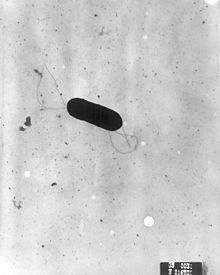
Back لستيريا مولدة للوحيدات Arabic لستيريا مولده للوحيدات ARZ Listèria monocitògena Catalan Listeria monocytogenes Czech Listeria monocytogenes German Λιστέρια η μονοκυτταρογόνος Greek Listeria monocytogenes Esperanto Listeria monocytogenes Spanish Listeeriabakter Estonian Listeria monocytogenes Basque
| Listeria monocytogenes | |
|---|---|

| |
| Scanning electron micrograph of Listeria monocytogenes. | |
| Scientific classification | |
| Domain: | Bacteria |
| Phylum: | Bacillota |
| Class: | Bacilli |
| Order: | Bacillales |
| Family: | Listeriaceae |
| Genus: | Listeria |
| Species: | L. monocytogenes
|
| Binomial name | |
| Listeria monocytogenes (E. Murray et al. 1926) Pirie 1940
| |
Listeria monocytogenes is the species of pathogenic bacteria that causes the infection listeriosis. It is a facultative anaerobic bacterium, capable of surviving in the presence or absence of oxygen. It can grow and reproduce inside the host's cells and is one of the most virulent foodborne pathogens. Twenty to thirty percent of foodborne listeriosis infections in high-risk individuals may be fatal.[1][2][3] In the European Union, listeriosis continues an upward trend that began in 2008, causing 2,161 confirmed cases and 210 reported deaths in 2014, 16% more than in 2013. In the EU, listeriosis mortality rates also are higher than those of other foodborne pathogens.[4][5] Responsible for an estimated 1,600 illnesses and 260 deaths in the United States annually, listeriosis ranks third in total number of deaths among foodborne bacterial pathogens, with fatality rates exceeding even Salmonella spp. and Clostridium botulinum.
Named for Joseph Lister, Listeria monocytogenes is a Gram-positive bacterium, in the phylum Bacillota. Its ability to grow at temperatures as low as 0 °C permits multiplication at typical refrigeration temperatures, greatly increasing its ability to evade control in human foodstuffs. Motile via flagella at 30 °C and below, but usually not at 37 °C,[6] L. monocytogenes can instead move within eukaryotic cells by explosive polymerization of actin filaments (known as comet tails or actin rockets).[3] Once Listeria monocytogenes enters the host cytoplasm, multiple changes in bacterial metabolism and gene expression help to complete its metamorphosis from soil dweller to intracellular pathogen.[7]
Studies suggest that up to 10% of human gastrointestinal tracts may be colonized by L. monocytogenes.[1] Nevertheless, clinical diseases due to L. monocytogenes are more frequently recognized by veterinarians, especially as meningoencephalitis in ruminants. See: listeriosis in animals.
Due to its frequent pathogenicity, causing meningitis in newborns (acquired transvaginally), pregnant women are often advised not to eat soft cheeses such as Brie, Camembert, feta, and queso blanco fresco, which may be contaminated with and permit growth of L. monocytogenes.[8] It is the third most common cause of meningitis in newborns. Listeria monocytogenes can infect the brain, spinal-cord membranes and bloodstream of the host[9] through the ingestion of contaminated food such as unpasteurized dairy or raw foods.[10]
- ^ a b Ramaswamy V, Cresence VM, Rejitha JS, Lekshmi MU, Dharsana KS, Prasad SP, et al. (February 2007). "Listeria--review of epidemiology and pathogenesis" (PDF). Journal of Microbiology, Immunology, and Infection = Wei Mian Yu Gan Ran Za Zhi. 40 (1): 4–13. PMID 17332901. Archived from the original (PDF) on 2020-03-31. Retrieved 2010-09-05.
- ^ Pizarro-Cerda J, Cossart, P (2019). "Microbe Profile: Listeria monocytogenes: a paradigm among intracellular bacterial pathogens". Microbiology. 165 (7): 719–721. doi:10.1099/mic.0.000800. PMID 31124782.
- ^ a b Pizarro-Cerdá J, Cossart P (2019-07-01). "Microbe Profile: Listeria monocytogenes: a paradigm among intracellular bacterial pathogens". Microbiology. 165 (7): 719–721. doi:10.1099/mic.0.000800. ISSN 1350-0872. PMID 31124782. S2CID 163166441.
- ^ "Campylobacter and Listeria infections still rising in the EU – say EFSA and ECDC - European Food Safety Authority". www.efsa.europa.eu. 2015-12-17.
- ^ "The European Union summary report on trends and sources of zoonoses, zoonotic agents and food-borne outbreaks in 2014". EFSA Journal. 13 (12). 2015. doi:10.2903/j.efsa.2015.4329.
- ^ Gründling A, Burrack LS, Bouwer HG, Higgins DE (August 2004). "Listeria monocytogenes regulates flagellar motility gene expression through MogR, a transcriptional repressor required for virulence". Proceedings of the National Academy of Sciences of the United States of America. 101 (33): 12318–23. Bibcode:2004PNAS..10112318G. doi:10.1073/pnas.0404924101. PMC 514476. PMID 15302931.
- ^ Freitag NE (2006). "From hot dogs to host cells: how the bacterial pathogen Listeria monocytogenes regulates virulence gene expression". Future Microbiology. 1 (1): 89–101. doi:10.2217/17460913.1.1.89. PMID 17661688. Retrieved 26 June 2006.
- ^ Genigeorgis C, Carniciu M, Dutulescu D, Farver TB (1991). "Growth and survival of Listeria monocytogenes in market cheeses stored at 4 to 30 degrees C". J. Food Prot. 54 (9): 662–668. doi:10.4315/0362-028X-54.9.662. PMID 31051570.
- ^ "Listeriosis (Listeria infection)". www.health.ny.gov. Retrieved 2015-11-16.
- ^ "CDC - Sources - Listeriosis". www.cdc.gov. Retrieved 2015-11-16.